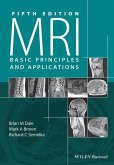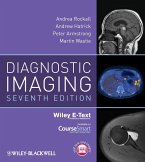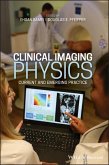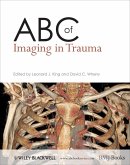- Gebundenes Buch
- Merkliste
- Auf die Merkliste
- Bewerten Bewerten
- Teilen
- Produkt teilen
- Produkterinnerung
- Produkterinnerung
"An excellent primer on medical imaging for all members of the medical profession . . . including non-radiological specialists. It is technically solid and filled with diagrams and clinical images illustrating important points, but it is also easily readable . . . So many outstanding chapters . . . The book uses little mathematics beyond simple algebra [and] presents complex ideas in very understandable terms." -Melvin E. Clouse, MD, Vice Chairman Emeritus, Department of Radiology, Beth Israel Deaconess Medical Center and Deaconess Professor of Radiology, Harvard Medical School
A well-known…mehr
Andere Kunden interessierten sich auch für
![Radiation Biology of Medical Imaging Radiation Biology of Medical Imaging]() Daniel SandovalRadiation Biology of Medical Imaging118,99 €
Daniel SandovalRadiation Biology of Medical Imaging118,99 €![MRI MRI]() Brian M. DaleMRI89,99 €
Brian M. DaleMRI89,99 €![Medical Image Analysis Medical Image Analysis]() Atam P. DhawanMedical Image Analysis171,99 €
Atam P. DhawanMedical Image Analysis171,99 €![Diagnostic Imaging Diagnostic Imaging]() Andrea G. RockallDiagnostic Imaging90,99 €
Andrea G. RockallDiagnostic Imaging90,99 €![Diagnostic Imaging of Infections and Inflammatory Diseases Diagnostic Imaging of Infections and Inflammatory Diseases]() Diagnostic Imaging of Infections and Inflammatory Diseases183,99 €
Diagnostic Imaging of Infections and Inflammatory Diseases183,99 €![Clinical Imaging Physics Clinical Imaging Physics]() Clinical Imaging Physics137,99 €
Clinical Imaging Physics137,99 €![ABC of Imaging in Trauma ABC of Imaging in Trauma]() ABC of Imaging in Trauma62,99 €
ABC of Imaging in Trauma62,99 €-
-
-
"An excellent primer on medical imaging for all members of the medical profession . . . including non-radiological specialists. It is technically solid and filled with diagrams and clinical images illustrating important points, but it is also easily readable . . . So many outstanding chapters . . . The book uses little mathematics beyond simple algebra [and] presents complex ideas in very understandable terms."
-Melvin E. Clouse, MD, Vice Chairman Emeritus, Department of Radiology, Beth Israel Deaconess Medical Center and Deaconess Professor of Radiology, Harvard Medical School
A well-known medical physicist and author, an interventional radiologist, and an emergency room physician with no special training in radiology have collaborated to write, in the language familiar to physicians, an introduction to the technology and clinical applications of medical imaging. It is intentionally brief and not overly detailed, intended to help clinicians with very little free time rapidly gain enough command of the critically important imaging tools of their trade to be able to discuss them confidently with medical and technical colleagues; to explain the general ideas accurately to students, nurses, and technologists; and to describe them effectively to concerned patients and loved ones. Chapter coverage includes:
Introduction: Dr. Doe's Headaches
Sketches of the Standard Imaging Modalities
Image Quality and Dose
Creating Subject Contrast in the Primary X-Ray Image
Twentieth-Century (Analog) Radiography and Fluoroscopy
Radiation Dose and Radiogenic Cancer Risk
Twenty-First-Century (Digital) Imaging
Digital Planar Imaging
Computed Tomography
Nuclear Medicine (Including SPECT and PET)
Diagnostic Ultrasound (Including Doppler)
MRI in One Dimension and with No Relaxation
Mapping T1 and T2 Proton Spin Relaxation in 3D
Evolving and Experimental Modalities
Hinweis: Dieser Artikel kann nur an eine deutsche Lieferadresse ausgeliefert werden.
-Melvin E. Clouse, MD, Vice Chairman Emeritus, Department of Radiology, Beth Israel Deaconess Medical Center and Deaconess Professor of Radiology, Harvard Medical School
A well-known medical physicist and author, an interventional radiologist, and an emergency room physician with no special training in radiology have collaborated to write, in the language familiar to physicians, an introduction to the technology and clinical applications of medical imaging. It is intentionally brief and not overly detailed, intended to help clinicians with very little free time rapidly gain enough command of the critically important imaging tools of their trade to be able to discuss them confidently with medical and technical colleagues; to explain the general ideas accurately to students, nurses, and technologists; and to describe them effectively to concerned patients and loved ones. Chapter coverage includes:
Introduction: Dr. Doe's Headaches
Sketches of the Standard Imaging Modalities
Image Quality and Dose
Creating Subject Contrast in the Primary X-Ray Image
Twentieth-Century (Analog) Radiography and Fluoroscopy
Radiation Dose and Radiogenic Cancer Risk
Twenty-First-Century (Digital) Imaging
Digital Planar Imaging
Computed Tomography
Nuclear Medicine (Including SPECT and PET)
Diagnostic Ultrasound (Including Doppler)
MRI in One Dimension and with No Relaxation
Mapping T1 and T2 Proton Spin Relaxation in 3D
Evolving and Experimental Modalities
Hinweis: Dieser Artikel kann nur an eine deutsche Lieferadresse ausgeliefert werden.
Produktdetails
- Produktdetails
- Verlag: Wiley & Sons
- 1. Auflage
- Seitenzahl: 448
- Erscheinungstermin: 4. Juni 2013
- Englisch
- Abmessung: 261mm x 182mm x 27mm
- Gewicht: 1076g
- ISBN-13: 9780470505700
- ISBN-10: 0470505702
- Artikelnr.: 36931813
- Verlag: Wiley & Sons
- 1. Auflage
- Seitenzahl: 448
- Erscheinungstermin: 4. Juni 2013
- Englisch
- Abmessung: 261mm x 182mm x 27mm
- Gewicht: 1076g
- ISBN-13: 9780470505700
- ISBN-10: 0470505702
- Artikelnr.: 36931813
Anthony Brinton Wolbarst, PhD, a physicist formerly at Harvard Medical School, the National Cancer Institute, and the U.S. Environmental Protection Agency, is currently an Associate Professor at the University of Kentucky College of Health Sciences, Division of Radiation Sciences and College of Medicine, Department of Diagnostic Radiology in Lexington, Kentucky, USA. Patrizio Capasso, MD, is Professor and Division Chief of Vascular & Interventional Radiology in the Departments of Diagnostic Radiology and Surgery at the University of Kentucky Chandler Medical Center Lexington, Kentucky, USA. Andrew R. Wyant, MD, is Assistant Professor for Physician Assistant Studies at the University of Kentucky Chandler Medical Center Lexington, Kentucky, USA. Among many other courses that he teaches is a popular clinical skills seminar in in Radiographic Interpretation.
Preface
x Acknowledgments
xiii Introduction: Dr. Doe's Headaches: An Imaging Case Study
xiv Computed tomography
xiv Picture archiving and communication system
xv T1
T2
and FLAIR MRI
xvi MR spectroscopy and a virtual biopsy
xvii Functional MRI
xviii Diffusion tensor MR imaging
xviii MR guided biopsy
xx Pathology
xxi Positron emission tomography?
xxi Treatment and follow-up
xxii 1 Sketches of the Standard Imaging Modalities: Different Ways of Creating Visible Contrast Among Tissues
1 "Roentgen has surely gone crazy!"
2 Different imaging probes interact with different tissues in different ways and yield different kinds of medical information
4 Twentieth-century (analog) radiography and fluoroscopy: contrast from differential attenuation of X-rays by tissues
7 Twenty-first century (digital) images and digital planar imaging: computer-based images and solid-state image receptors
16 Computed tomography: three-dimensional mapping of X-ray attenuation by tissues
17 Nuclear medicine
including SPECT and PET: contrast from the differential uptake of a radiopharmaceutical by tissues
20 Diagnostic ultrasound: contrast from differences in tissue elasticity or density
26 Magnetic resonance imaging: mapping the spatial distribution of spin-relaxation times of hydrogen nuclei in tissue water and lipids
28 Appendix: selection of imaging modalities to assist in medical diagnosis
30 References
36 2 Image Quality and Dose: What Constitutes a "Good" Medical Image?
37 A brief history of magnetism
37 About those probes and their interactions with matter . . .
39 The image quality quartet: contrast
resolution
stochastic (random) noise
artifacts - and always dose
47 Quality assurance
57 Known medical benefits versus potential radiation risks
61 3 Creating Subject Contrast in the Primary X-ray Image: Projection Maps of the Body from Differential Attenuation of X-rays by Tissues
67 Creating a (nearly) uniform beam of penetrating X-rays
69 Interaction of X-ray and gamma-ray photons with tissues or an image receptor
75 What a body does to the beam: subject contrast in the pattern of X-rays emerging from the patient
83 What the beam does to a body: dose and risk
87 4 Twentieth-century (Analog) Radiography and Fluoroscopy: Capturing the X-ray Shadow with a Film Cassette or an Image Intensifier Tube plus Electronic Optical Camera Combination
91 Recording the X-ray pattern emerging from the patient with a screen-film image receptor
92 Prime determinants/measures of image quality: contrast
resolution
random noise
artifacts
. . . and
always
patient dose
98 Special requirements for mammography
114 Image intensifier-tube fluoroscopy: viewing in real time
122 Conclusion: bringing radiography and fluoroscopy into the twenty-first century with solid-state digital X-ray image receptors
125 Reference
126 5 Radiation Dose and Radiogenic Risk: Ionization-Induced Damage to DNA can cause Stochastic
Deterministic
and Teratogenic Health Effects - And How To Protect Against Them
127 Our exposure to ionizing radiation has doubled over the past few decades
127 Radiation health effects are caused by damage to DNA
129 Stochastic health effects: cancer may arise from mutations in a single cell
132 Deterministic health effects at high doses: radiation killing of a large number of tissue cells
139 The Four Quartets of radiation safety
146 References
151 6 Twenty-first Century (Digital) Imaging: Computer-Based Representation
Acquisition
Processing
Storage
Transmission
and Analysis of Images
152 Digital computers
153 Digital acquisition and representation of an image
157 Digital image processing: enhancing tissue contrast
SNR
edge sharpness
etc.
166 Computer networks: PACS
RIS
and the Internet
168 Image analysis and interpretation: computer-assisted detection
170 Computer and computer-network security
172 Liquid crystal displays and other digital displays
173 The joy of digital
174 7 Digital Planar Imaging: Replacing Film and Image Intensifiers with Solid State
Electronic Image Receptors
176 Digital planar imaging modalities
176 Indirect detection with a fluorescent screen and a CCD
178 Computed radiography
178 Digital radiography with an active matrix flat panel imager
179 Digital mammography
184 Digital fluoroscopy and digital subtraction angiography
186 Digital tomosynthesis: planar imaging in three dimensions
189 References
190 8 Computed Tomography: Superior Contrast in Three-Dimensional X-Ray Attenuation Maps
191 Computed tomography maps out X-ray attenuation in two and three dimensions
192 Image reconstruction
198 Seven generations of CT scanners
204 Technology and image quality
208 Patient- and machine-caused artifacts
219 Dose and QA
221 Appendix: mathematical basis of filtered back-projection
229 References
233 9 Nuclear Medicine: Contrast from Differential Uptake of a Radiopharmaceutical by Tissues
234 Unstable atomic nuclei: radioactivity
235 Radiopharmaceuticals: gamma- or positron-emitting radionuclei attached to organ-specific agents
245 Imaging radiopharmaceutical concentration with a gamma camera
248 Static and dynamic studies
254 Tomographic nuclear imaging: SPECT and PET
260 Quality assurance and radiation safety
270 References
273 10 Diagnostic Ultrasound: Contrast from Differences in Tissue Elasticity or Density Across Boundaries
274 Medical ultrasound
274 The US beam: MHz compressional waves in tissues
277 Production of an ultrasound beam and detection of echoes with a transducer
280 Piezoelectric transducer elements
281 Transmission and attenuation of the beam within a homogeneous material
285 Reflection of the beam at an interface between materials with different acoustic impedances
288 Imaging in 1 and 1 × 1 dimensions: A- and M-modes
291 Imaging in two
three
and four dimensions: B-mode
294 Doppler imaging of blood flow
300 Elastography
302 Safety and QA
303 11 MRI in One Dimension and with No Relaxation: A Gentle Introduction to a Challenging Subject
307 Prologue to MRI
308 "Quantum" approach to proton nuclear magnetic resonance
310 Magnetic resonance imaging in one dimension
316 "Classical" approach to NMR
321 Free induction decay imaging (but without the decay)
331 Spin-echo imaging (still without T1 or T2 relaxation)
338 MRI instrumentation
343 Reference
351 12 Mapping T1 and T2 Relaxation in Three Dimensions
352 Longitudinal spin relaxation and T1
353 Transverse spin relaxation and T2-w images
364 T2* and the gradient-echo (G-E) pulse sequence
372 Into two and three dimensions
374 MR imaging of fluid movement/motion
382 13 Evolving and Experimental Modalities
387 Optical and near-infrared imaging
388 Molecular imaging and nanotechnology
390 Thermography
392 Terahertz (T-ray) imaging of epithelial tissues
393 Microwave and electron spin resonance imaging
393 Electroencephalography
magnetocardiography
and impedance imaging
394 Photo-acoustic imaging
396 Computer technology: the constant revolution
397 Imaging with a crystal ball
399 References
399 Suggested Further Reading
400 Index
403
x Acknowledgments
xiii Introduction: Dr. Doe's Headaches: An Imaging Case Study
xiv Computed tomography
xiv Picture archiving and communication system
xv T1
T2
and FLAIR MRI
xvi MR spectroscopy and a virtual biopsy
xvii Functional MRI
xviii Diffusion tensor MR imaging
xviii MR guided biopsy
xx Pathology
xxi Positron emission tomography?
xxi Treatment and follow-up
xxii 1 Sketches of the Standard Imaging Modalities: Different Ways of Creating Visible Contrast Among Tissues
1 "Roentgen has surely gone crazy!"
2 Different imaging probes interact with different tissues in different ways and yield different kinds of medical information
4 Twentieth-century (analog) radiography and fluoroscopy: contrast from differential attenuation of X-rays by tissues
7 Twenty-first century (digital) images and digital planar imaging: computer-based images and solid-state image receptors
16 Computed tomography: three-dimensional mapping of X-ray attenuation by tissues
17 Nuclear medicine
including SPECT and PET: contrast from the differential uptake of a radiopharmaceutical by tissues
20 Diagnostic ultrasound: contrast from differences in tissue elasticity or density
26 Magnetic resonance imaging: mapping the spatial distribution of spin-relaxation times of hydrogen nuclei in tissue water and lipids
28 Appendix: selection of imaging modalities to assist in medical diagnosis
30 References
36 2 Image Quality and Dose: What Constitutes a "Good" Medical Image?
37 A brief history of magnetism
37 About those probes and their interactions with matter . . .
39 The image quality quartet: contrast
resolution
stochastic (random) noise
artifacts - and always dose
47 Quality assurance
57 Known medical benefits versus potential radiation risks
61 3 Creating Subject Contrast in the Primary X-ray Image: Projection Maps of the Body from Differential Attenuation of X-rays by Tissues
67 Creating a (nearly) uniform beam of penetrating X-rays
69 Interaction of X-ray and gamma-ray photons with tissues or an image receptor
75 What a body does to the beam: subject contrast in the pattern of X-rays emerging from the patient
83 What the beam does to a body: dose and risk
87 4 Twentieth-century (Analog) Radiography and Fluoroscopy: Capturing the X-ray Shadow with a Film Cassette or an Image Intensifier Tube plus Electronic Optical Camera Combination
91 Recording the X-ray pattern emerging from the patient with a screen-film image receptor
92 Prime determinants/measures of image quality: contrast
resolution
random noise
artifacts
. . . and
always
patient dose
98 Special requirements for mammography
114 Image intensifier-tube fluoroscopy: viewing in real time
122 Conclusion: bringing radiography and fluoroscopy into the twenty-first century with solid-state digital X-ray image receptors
125 Reference
126 5 Radiation Dose and Radiogenic Risk: Ionization-Induced Damage to DNA can cause Stochastic
Deterministic
and Teratogenic Health Effects - And How To Protect Against Them
127 Our exposure to ionizing radiation has doubled over the past few decades
127 Radiation health effects are caused by damage to DNA
129 Stochastic health effects: cancer may arise from mutations in a single cell
132 Deterministic health effects at high doses: radiation killing of a large number of tissue cells
139 The Four Quartets of radiation safety
146 References
151 6 Twenty-first Century (Digital) Imaging: Computer-Based Representation
Acquisition
Processing
Storage
Transmission
and Analysis of Images
152 Digital computers
153 Digital acquisition and representation of an image
157 Digital image processing: enhancing tissue contrast
SNR
edge sharpness
etc.
166 Computer networks: PACS
RIS
and the Internet
168 Image analysis and interpretation: computer-assisted detection
170 Computer and computer-network security
172 Liquid crystal displays and other digital displays
173 The joy of digital
174 7 Digital Planar Imaging: Replacing Film and Image Intensifiers with Solid State
Electronic Image Receptors
176 Digital planar imaging modalities
176 Indirect detection with a fluorescent screen and a CCD
178 Computed radiography
178 Digital radiography with an active matrix flat panel imager
179 Digital mammography
184 Digital fluoroscopy and digital subtraction angiography
186 Digital tomosynthesis: planar imaging in three dimensions
189 References
190 8 Computed Tomography: Superior Contrast in Three-Dimensional X-Ray Attenuation Maps
191 Computed tomography maps out X-ray attenuation in two and three dimensions
192 Image reconstruction
198 Seven generations of CT scanners
204 Technology and image quality
208 Patient- and machine-caused artifacts
219 Dose and QA
221 Appendix: mathematical basis of filtered back-projection
229 References
233 9 Nuclear Medicine: Contrast from Differential Uptake of a Radiopharmaceutical by Tissues
234 Unstable atomic nuclei: radioactivity
235 Radiopharmaceuticals: gamma- or positron-emitting radionuclei attached to organ-specific agents
245 Imaging radiopharmaceutical concentration with a gamma camera
248 Static and dynamic studies
254 Tomographic nuclear imaging: SPECT and PET
260 Quality assurance and radiation safety
270 References
273 10 Diagnostic Ultrasound: Contrast from Differences in Tissue Elasticity or Density Across Boundaries
274 Medical ultrasound
274 The US beam: MHz compressional waves in tissues
277 Production of an ultrasound beam and detection of echoes with a transducer
280 Piezoelectric transducer elements
281 Transmission and attenuation of the beam within a homogeneous material
285 Reflection of the beam at an interface between materials with different acoustic impedances
288 Imaging in 1 and 1 × 1 dimensions: A- and M-modes
291 Imaging in two
three
and four dimensions: B-mode
294 Doppler imaging of blood flow
300 Elastography
302 Safety and QA
303 11 MRI in One Dimension and with No Relaxation: A Gentle Introduction to a Challenging Subject
307 Prologue to MRI
308 "Quantum" approach to proton nuclear magnetic resonance
310 Magnetic resonance imaging in one dimension
316 "Classical" approach to NMR
321 Free induction decay imaging (but without the decay)
331 Spin-echo imaging (still without T1 or T2 relaxation)
338 MRI instrumentation
343 Reference
351 12 Mapping T1 and T2 Relaxation in Three Dimensions
352 Longitudinal spin relaxation and T1
353 Transverse spin relaxation and T2-w images
364 T2* and the gradient-echo (G-E) pulse sequence
372 Into two and three dimensions
374 MR imaging of fluid movement/motion
382 13 Evolving and Experimental Modalities
387 Optical and near-infrared imaging
388 Molecular imaging and nanotechnology
390 Thermography
392 Terahertz (T-ray) imaging of epithelial tissues
393 Microwave and electron spin resonance imaging
393 Electroencephalography
magnetocardiography
and impedance imaging
394 Photo-acoustic imaging
396 Computer technology: the constant revolution
397 Imaging with a crystal ball
399 References
399 Suggested Further Reading
400 Index
403
Preface
x Acknowledgments
xiii Introduction: Dr. Doe's Headaches: An Imaging Case Study
xiv Computed tomography
xiv Picture archiving and communication system
xv T1
T2
and FLAIR MRI
xvi MR spectroscopy and a virtual biopsy
xvii Functional MRI
xviii Diffusion tensor MR imaging
xviii MR guided biopsy
xx Pathology
xxi Positron emission tomography?
xxi Treatment and follow-up
xxii 1 Sketches of the Standard Imaging Modalities: Different Ways of Creating Visible Contrast Among Tissues
1 "Roentgen has surely gone crazy!"
2 Different imaging probes interact with different tissues in different ways and yield different kinds of medical information
4 Twentieth-century (analog) radiography and fluoroscopy: contrast from differential attenuation of X-rays by tissues
7 Twenty-first century (digital) images and digital planar imaging: computer-based images and solid-state image receptors
16 Computed tomography: three-dimensional mapping of X-ray attenuation by tissues
17 Nuclear medicine
including SPECT and PET: contrast from the differential uptake of a radiopharmaceutical by tissues
20 Diagnostic ultrasound: contrast from differences in tissue elasticity or density
26 Magnetic resonance imaging: mapping the spatial distribution of spin-relaxation times of hydrogen nuclei in tissue water and lipids
28 Appendix: selection of imaging modalities to assist in medical diagnosis
30 References
36 2 Image Quality and Dose: What Constitutes a "Good" Medical Image?
37 A brief history of magnetism
37 About those probes and their interactions with matter . . .
39 The image quality quartet: contrast
resolution
stochastic (random) noise
artifacts - and always dose
47 Quality assurance
57 Known medical benefits versus potential radiation risks
61 3 Creating Subject Contrast in the Primary X-ray Image: Projection Maps of the Body from Differential Attenuation of X-rays by Tissues
67 Creating a (nearly) uniform beam of penetrating X-rays
69 Interaction of X-ray and gamma-ray photons with tissues or an image receptor
75 What a body does to the beam: subject contrast in the pattern of X-rays emerging from the patient
83 What the beam does to a body: dose and risk
87 4 Twentieth-century (Analog) Radiography and Fluoroscopy: Capturing the X-ray Shadow with a Film Cassette or an Image Intensifier Tube plus Electronic Optical Camera Combination
91 Recording the X-ray pattern emerging from the patient with a screen-film image receptor
92 Prime determinants/measures of image quality: contrast
resolution
random noise
artifacts
. . . and
always
patient dose
98 Special requirements for mammography
114 Image intensifier-tube fluoroscopy: viewing in real time
122 Conclusion: bringing radiography and fluoroscopy into the twenty-first century with solid-state digital X-ray image receptors
125 Reference
126 5 Radiation Dose and Radiogenic Risk: Ionization-Induced Damage to DNA can cause Stochastic
Deterministic
and Teratogenic Health Effects - And How To Protect Against Them
127 Our exposure to ionizing radiation has doubled over the past few decades
127 Radiation health effects are caused by damage to DNA
129 Stochastic health effects: cancer may arise from mutations in a single cell
132 Deterministic health effects at high doses: radiation killing of a large number of tissue cells
139 The Four Quartets of radiation safety
146 References
151 6 Twenty-first Century (Digital) Imaging: Computer-Based Representation
Acquisition
Processing
Storage
Transmission
and Analysis of Images
152 Digital computers
153 Digital acquisition and representation of an image
157 Digital image processing: enhancing tissue contrast
SNR
edge sharpness
etc.
166 Computer networks: PACS
RIS
and the Internet
168 Image analysis and interpretation: computer-assisted detection
170 Computer and computer-network security
172 Liquid crystal displays and other digital displays
173 The joy of digital
174 7 Digital Planar Imaging: Replacing Film and Image Intensifiers with Solid State
Electronic Image Receptors
176 Digital planar imaging modalities
176 Indirect detection with a fluorescent screen and a CCD
178 Computed radiography
178 Digital radiography with an active matrix flat panel imager
179 Digital mammography
184 Digital fluoroscopy and digital subtraction angiography
186 Digital tomosynthesis: planar imaging in three dimensions
189 References
190 8 Computed Tomography: Superior Contrast in Three-Dimensional X-Ray Attenuation Maps
191 Computed tomography maps out X-ray attenuation in two and three dimensions
192 Image reconstruction
198 Seven generations of CT scanners
204 Technology and image quality
208 Patient- and machine-caused artifacts
219 Dose and QA
221 Appendix: mathematical basis of filtered back-projection
229 References
233 9 Nuclear Medicine: Contrast from Differential Uptake of a Radiopharmaceutical by Tissues
234 Unstable atomic nuclei: radioactivity
235 Radiopharmaceuticals: gamma- or positron-emitting radionuclei attached to organ-specific agents
245 Imaging radiopharmaceutical concentration with a gamma camera
248 Static and dynamic studies
254 Tomographic nuclear imaging: SPECT and PET
260 Quality assurance and radiation safety
270 References
273 10 Diagnostic Ultrasound: Contrast from Differences in Tissue Elasticity or Density Across Boundaries
274 Medical ultrasound
274 The US beam: MHz compressional waves in tissues
277 Production of an ultrasound beam and detection of echoes with a transducer
280 Piezoelectric transducer elements
281 Transmission and attenuation of the beam within a homogeneous material
285 Reflection of the beam at an interface between materials with different acoustic impedances
288 Imaging in 1 and 1 × 1 dimensions: A- and M-modes
291 Imaging in two
three
and four dimensions: B-mode
294 Doppler imaging of blood flow
300 Elastography
302 Safety and QA
303 11 MRI in One Dimension and with No Relaxation: A Gentle Introduction to a Challenging Subject
307 Prologue to MRI
308 "Quantum" approach to proton nuclear magnetic resonance
310 Magnetic resonance imaging in one dimension
316 "Classical" approach to NMR
321 Free induction decay imaging (but without the decay)
331 Spin-echo imaging (still without T1 or T2 relaxation)
338 MRI instrumentation
343 Reference
351 12 Mapping T1 and T2 Relaxation in Three Dimensions
352 Longitudinal spin relaxation and T1
353 Transverse spin relaxation and T2-w images
364 T2* and the gradient-echo (G-E) pulse sequence
372 Into two and three dimensions
374 MR imaging of fluid movement/motion
382 13 Evolving and Experimental Modalities
387 Optical and near-infrared imaging
388 Molecular imaging and nanotechnology
390 Thermography
392 Terahertz (T-ray) imaging of epithelial tissues
393 Microwave and electron spin resonance imaging
393 Electroencephalography
magnetocardiography
and impedance imaging
394 Photo-acoustic imaging
396 Computer technology: the constant revolution
397 Imaging with a crystal ball
399 References
399 Suggested Further Reading
400 Index
403
x Acknowledgments
xiii Introduction: Dr. Doe's Headaches: An Imaging Case Study
xiv Computed tomography
xiv Picture archiving and communication system
xv T1
T2
and FLAIR MRI
xvi MR spectroscopy and a virtual biopsy
xvii Functional MRI
xviii Diffusion tensor MR imaging
xviii MR guided biopsy
xx Pathology
xxi Positron emission tomography?
xxi Treatment and follow-up
xxii 1 Sketches of the Standard Imaging Modalities: Different Ways of Creating Visible Contrast Among Tissues
1 "Roentgen has surely gone crazy!"
2 Different imaging probes interact with different tissues in different ways and yield different kinds of medical information
4 Twentieth-century (analog) radiography and fluoroscopy: contrast from differential attenuation of X-rays by tissues
7 Twenty-first century (digital) images and digital planar imaging: computer-based images and solid-state image receptors
16 Computed tomography: three-dimensional mapping of X-ray attenuation by tissues
17 Nuclear medicine
including SPECT and PET: contrast from the differential uptake of a radiopharmaceutical by tissues
20 Diagnostic ultrasound: contrast from differences in tissue elasticity or density
26 Magnetic resonance imaging: mapping the spatial distribution of spin-relaxation times of hydrogen nuclei in tissue water and lipids
28 Appendix: selection of imaging modalities to assist in medical diagnosis
30 References
36 2 Image Quality and Dose: What Constitutes a "Good" Medical Image?
37 A brief history of magnetism
37 About those probes and their interactions with matter . . .
39 The image quality quartet: contrast
resolution
stochastic (random) noise
artifacts - and always dose
47 Quality assurance
57 Known medical benefits versus potential radiation risks
61 3 Creating Subject Contrast in the Primary X-ray Image: Projection Maps of the Body from Differential Attenuation of X-rays by Tissues
67 Creating a (nearly) uniform beam of penetrating X-rays
69 Interaction of X-ray and gamma-ray photons with tissues or an image receptor
75 What a body does to the beam: subject contrast in the pattern of X-rays emerging from the patient
83 What the beam does to a body: dose and risk
87 4 Twentieth-century (Analog) Radiography and Fluoroscopy: Capturing the X-ray Shadow with a Film Cassette or an Image Intensifier Tube plus Electronic Optical Camera Combination
91 Recording the X-ray pattern emerging from the patient with a screen-film image receptor
92 Prime determinants/measures of image quality: contrast
resolution
random noise
artifacts
. . . and
always
patient dose
98 Special requirements for mammography
114 Image intensifier-tube fluoroscopy: viewing in real time
122 Conclusion: bringing radiography and fluoroscopy into the twenty-first century with solid-state digital X-ray image receptors
125 Reference
126 5 Radiation Dose and Radiogenic Risk: Ionization-Induced Damage to DNA can cause Stochastic
Deterministic
and Teratogenic Health Effects - And How To Protect Against Them
127 Our exposure to ionizing radiation has doubled over the past few decades
127 Radiation health effects are caused by damage to DNA
129 Stochastic health effects: cancer may arise from mutations in a single cell
132 Deterministic health effects at high doses: radiation killing of a large number of tissue cells
139 The Four Quartets of radiation safety
146 References
151 6 Twenty-first Century (Digital) Imaging: Computer-Based Representation
Acquisition
Processing
Storage
Transmission
and Analysis of Images
152 Digital computers
153 Digital acquisition and representation of an image
157 Digital image processing: enhancing tissue contrast
SNR
edge sharpness
etc.
166 Computer networks: PACS
RIS
and the Internet
168 Image analysis and interpretation: computer-assisted detection
170 Computer and computer-network security
172 Liquid crystal displays and other digital displays
173 The joy of digital
174 7 Digital Planar Imaging: Replacing Film and Image Intensifiers with Solid State
Electronic Image Receptors
176 Digital planar imaging modalities
176 Indirect detection with a fluorescent screen and a CCD
178 Computed radiography
178 Digital radiography with an active matrix flat panel imager
179 Digital mammography
184 Digital fluoroscopy and digital subtraction angiography
186 Digital tomosynthesis: planar imaging in three dimensions
189 References
190 8 Computed Tomography: Superior Contrast in Three-Dimensional X-Ray Attenuation Maps
191 Computed tomography maps out X-ray attenuation in two and three dimensions
192 Image reconstruction
198 Seven generations of CT scanners
204 Technology and image quality
208 Patient- and machine-caused artifacts
219 Dose and QA
221 Appendix: mathematical basis of filtered back-projection
229 References
233 9 Nuclear Medicine: Contrast from Differential Uptake of a Radiopharmaceutical by Tissues
234 Unstable atomic nuclei: radioactivity
235 Radiopharmaceuticals: gamma- or positron-emitting radionuclei attached to organ-specific agents
245 Imaging radiopharmaceutical concentration with a gamma camera
248 Static and dynamic studies
254 Tomographic nuclear imaging: SPECT and PET
260 Quality assurance and radiation safety
270 References
273 10 Diagnostic Ultrasound: Contrast from Differences in Tissue Elasticity or Density Across Boundaries
274 Medical ultrasound
274 The US beam: MHz compressional waves in tissues
277 Production of an ultrasound beam and detection of echoes with a transducer
280 Piezoelectric transducer elements
281 Transmission and attenuation of the beam within a homogeneous material
285 Reflection of the beam at an interface between materials with different acoustic impedances
288 Imaging in 1 and 1 × 1 dimensions: A- and M-modes
291 Imaging in two
three
and four dimensions: B-mode
294 Doppler imaging of blood flow
300 Elastography
302 Safety and QA
303 11 MRI in One Dimension and with No Relaxation: A Gentle Introduction to a Challenging Subject
307 Prologue to MRI
308 "Quantum" approach to proton nuclear magnetic resonance
310 Magnetic resonance imaging in one dimension
316 "Classical" approach to NMR
321 Free induction decay imaging (but without the decay)
331 Spin-echo imaging (still without T1 or T2 relaxation)
338 MRI instrumentation
343 Reference
351 12 Mapping T1 and T2 Relaxation in Three Dimensions
352 Longitudinal spin relaxation and T1
353 Transverse spin relaxation and T2-w images
364 T2* and the gradient-echo (G-E) pulse sequence
372 Into two and three dimensions
374 MR imaging of fluid movement/motion
382 13 Evolving and Experimental Modalities
387 Optical and near-infrared imaging
388 Molecular imaging and nanotechnology
390 Thermography
392 Terahertz (T-ray) imaging of epithelial tissues
393 Microwave and electron spin resonance imaging
393 Electroencephalography
magnetocardiography
and impedance imaging
394 Photo-acoustic imaging
396 Computer technology: the constant revolution
397 Imaging with a crystal ball
399 References
399 Suggested Further Reading
400 Index
403







